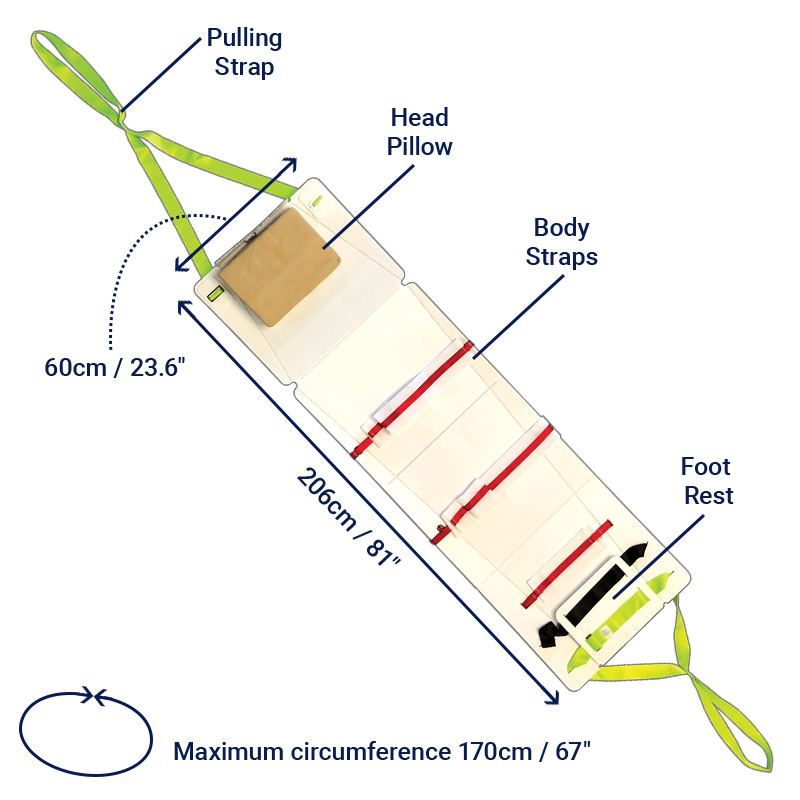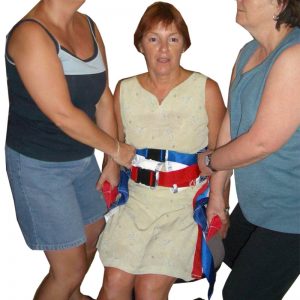The ResQme is designed to safely evacuate a non-ambulant person from a building in an emergency situation. The Evacuee may be in a wheelchair or they may not be able to walk down stairs, if the lifts are not available due to fire or an electrical failure.
The ResQme is a bright yellow/gold colour with bright green Pulling Straps to stand out in poor light conditions. The yellow Storage Bag and Pulling Straps have some Hi Vis Tape made to Australian Standard 906.4. Many fires start at night. If the electricity is turned off, Rescuers need to find the ResQme in poor light. Outside of the building, the bright colours and reflective tape will help the outside Rescuers see the ResQme coming. This allows them to assist evacuation away from the building.
In any building over two storeys high, if there is a power failure or a fire, the electricity is turned off and the lifts or elevators then cannot be used. It is difficult and probably impossible, for people in wheelchairs or using Zimmer Frames or walking sticks, to walk down stairs. The ResQme can be used in office buildings, theatres, libraries, hospitals, schools, etc. Even if a wheelchair user does not work in the building, a wheelchair user may be in the building when there is a power failure or fire, and they will not be able to use the stairs to evacuate. When not in use, the ResQme can hang from a hook or be stored in a cupboard, ready to use when an evacuation is necessary.
This item is not suitable for most spiral staircases.
To Use
Take the ResQme to the Patient. Remove the strap that is around the ResQme and unfold the ResQme.
When putting the Patient on top of the ResQme, place their head on the pillow with their shoulders close to the edge of the pillow. The oversize pillow is to protect the Patient’s head when going around corners.
The methods outlined below are only some suggested ways of placing the Patient onto the ResQme. Your Manual Handling Advisor may have a better suggestion for this task.
If the Patient is in bed
Log roll the Patient to place the ResQme under them.
If the Patient is in a chair
Place the ResQme on the floor in front of the chair with the pillow near the Patient’s feet. If they are in a wheelchair, apply the brakes, remove the foot plates or swing them out of the way. Lift the Patient’s legs to pull them, so they slide down into the ResQme. This is easier if a second Carer can hold the Patient under the arms to help them slide, remember this is only used for an emergency evacuation. It also may be possible to stand the Patient and have the ResQme near the chair to lay the Patient onto the ResQme. There may not be enough Carers, so always ask your Manual Handling Advisor to learn a safe method for patients and Carers.
When the Patient is on the ResQme
Place the person’s feet at the foot end, hard up against the plastic. Secure the Hook & Loop Tape to hold the person in. Position the pillow so it is comfortable under the head.
There is a second pulling strap located at the head end and this can be used to help lower someone from a bed or if it is necessary, to pull from the head end of the ResQme. This strap can be used to help the descent if going down stairs; on stair landings; turning around corners etc. In most evacuations this pulling strap will be kept out of the way, by storing it under the pillow. As there is less strain to pull from the foot end, only use the head pulling strap if necessary.
The Patient should be pulled clear of the building to a designated muster area approved by your facility.
It is important that all staff have manual handling training in using the ResQme, so they will know how to use it in an emergency. When training, it may be better to stop the training by the escape door, because if the ResQme is dragged across a driveway, the bottom surface may be scratched beyond repair. Proposed escape routes should be trialed for evacuation in different directions depending on where the fire may start. It may be necessary to move some furniture to allow more room to move.
Maintenance
We recommend you inspect annually, to ensure vermin have not caused any damage. The direction of the corrugations on the plastic board means that its not necessary to unroll it every few months.
The full range of ResQproduct options are listed below. Click here to view the Features List for the range of Pelican evacuation devices.
 |
ResQsheet | Stored under the Patient’s mattress on the bed and is ready to use, with the Patient then evacuated with their mattress. Slides well on most vinyl floors. |
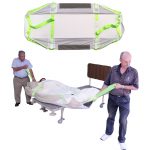 |
ResQsheet for Vinyl & Carpet | Same as the ResQsheet above, but with a built-in white plastic slide board underneath. Slides well on all floor surfaces including Vinyl & Carpet. |
 |
ResQsheet for Vinyl & Carpet – Deep & Airflow | A special version of our ResQsheet for Vinyl & Carpet, made to fit deep mattress beds, and can also be used with pressure care air-flow mattresses. |
 |
ResQme | This is kept in storage and taken to a Patient who needs to be evacuated. A budget option evacuation device. |
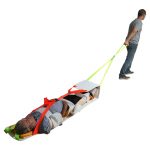 |
ResQpod | Same as the ResQme above, but with more Cross Straps to contain the Patient. |
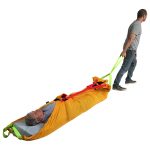 |
ResQmat | Same as the ResQme and ResQpod above, but with a built-in mini-mattress for comfort, and the side material can enclose the Patient. |
 |
ResQslide Board & Chair Strap Kit | The ResQslide Board & Chair Strap Kit is used to slide someone from a wheelchair to an evacuation device on the floor, such as the ResQmat, ResQpod or ResQme which can slide down stairs. |



